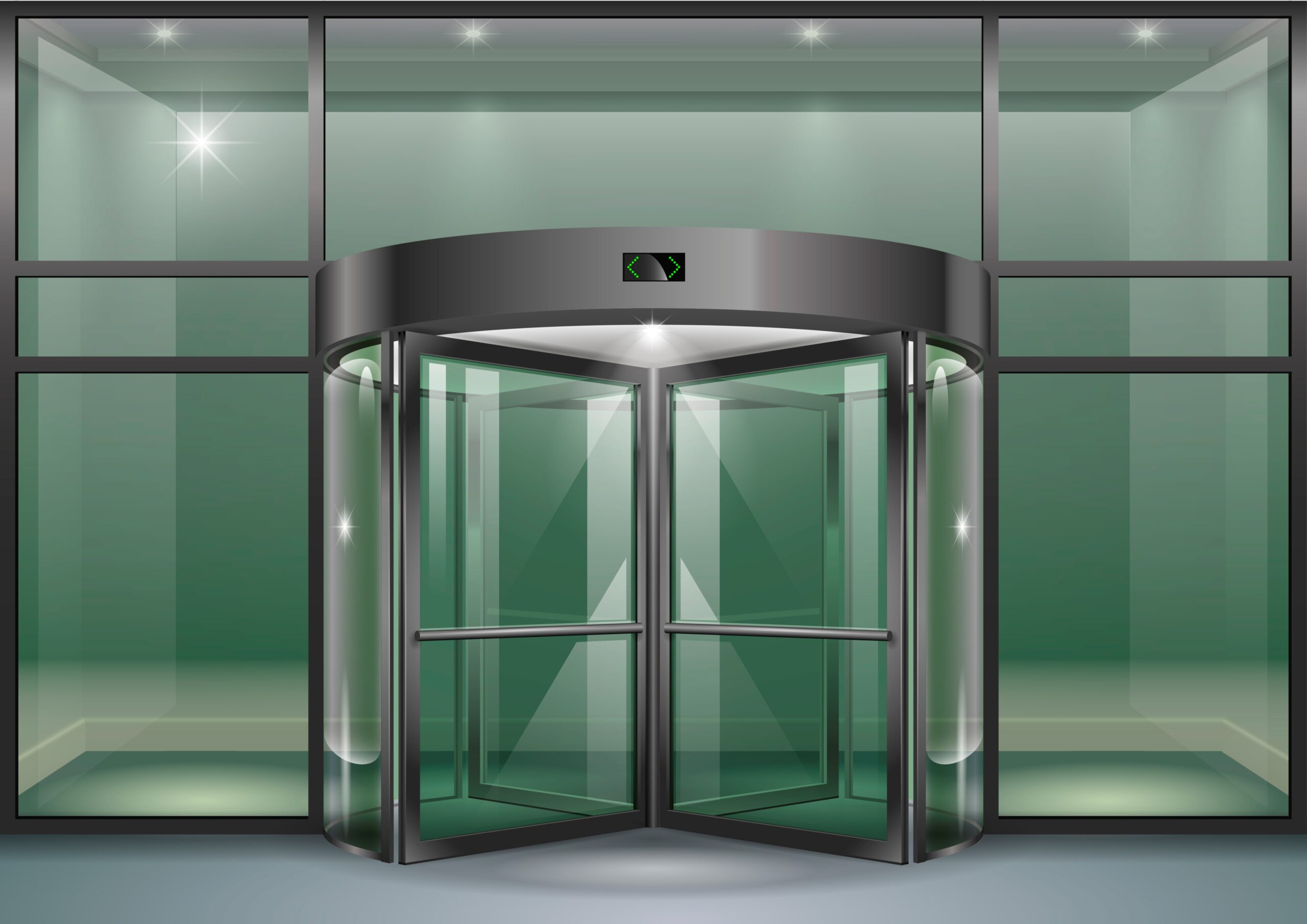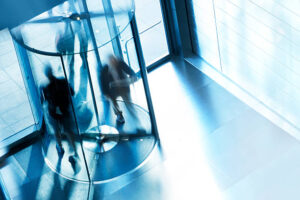Revolving doors are recognizable representations of effectiveness, style, and utility in the field of modern architecture. These creative gateways are much more than just an entry feature; they have several advantages that go beyond just the visual appeal. Revolving doors have established themselves as a favored option in commercial, institutional, and high-traffic areas globally, offering benefits ranging from increased energy efficiency to better traffic flow and security. In today’s blog, we’ll examine the many benefits of revolving doors and explain why they are still a mainstay of contemporary architectural design.
The Mechanics Behind Revolving Doors
The revolving circular or semi-circular panels that are usually included within a cylindrical casing are what define a revolving door. These panels can spin in response to human pressure because of their central pivot mounting. Due to this special design, revolving doors can be used to manage pedestrian traffic practically and effectively by enabling simultaneous entry and exit without requiring manual operation.
Revolving doors are made to regulate who enters and exits a building from a security perspective. They can help to improve security and stop unwanted access by controlling the number of individuals going through at any given moment. Because of such characteristics, revolving doors are particularly common in places where controlled access is crucial, such as hotels, office buildings, and commercial buildings.
Additionally, revolving doors are a common way for a building’s façade to stand out because of their modern, sleek design, which adds grandeur and elegance. In addition to being new and convenient, their automated operation makes a lasting impression on guests entering or departing a location.
What Difference Do Revolving Doors Make?
Revolving doors offer a lot of features that could make a huge difference for building owners in any sort of setting and for a variety of requirements. Here are a few of the many advantages offered by revolving doors:
Energy Efficiency Benefits
Thermal Insulation:
Revolving doors have several benefits, one of which is that they can improve a building’s thermal insulation. They retain a nearly continuous seal around their perimeter, as opposed to swing or slide doors that, when open, can let in large drafts. As a result, there is less air interaction between the indoor and outdoor environments, which lowers the amount of heat loss and heat gain. Moreover, revolving doors assist buildings in maintaining consistent internal temperatures and lessen the strain on HVAC systems by acting as an efficient airlock, resulting in less energy use and operating expenses, supporting broader sustainability initiatives.
Airflow Control:
Revolving doors not only provide thermal insulation but also allow for regulated ventilation within structures. These doors stop dirt, toxins, and other outside elements from entering indoor areas by controlling airflow via the entry. This is especially helpful in urban areas and high-traffic regions since airborne particulates can lower indoor air quality. Revolving doors produce a barrier that successfully protects interior spaces from outside contaminants, giving building occupants a cleaner and healthier indoor environment.
Noise Reduction:
Revolving doors remarkably contribute to noise pollution management by minimizing the amount of outside noise that enters interior spaces. They absorb and deflect sound from the surrounding environment thanks to their enclosed structure and continuous closure. This is especially helpful for buildings near transit hubs or in busy urban areas where noise pollution can affect the comfort and productivity of building occupants. Revolving doors improve acoustic insulation, which makes interior spaces quieter and better for focus, relaxation, and general well-being.
Safety and Security
Controlled Access:
Revolving doors provide regulated entry to buildings, making it possible to effectively monitor and control pedestrian flow. These doors demand intentional entry and exit procedures, as opposed to open entrances or traditional doors that can be left ajar or forced open. This restricted access strengthens security protocols, discourages trespassing, and lowers the possibility of unwanted entry. Therefore, revolving doors are considered a safer way to enter and exit commercial and institutional facilities, including hotels, offices, and airports.
Traffic Management:
Even during times when pedestrian traffic is at its highest, the design of revolving doors allows for efficient and well-organized traffic flow. These doors reduce traffic at pathways and prevent bottlenecks by allowing simultaneous entry and exit movements. This is especially helpful in places where there is a lot of foot traffic, including transit hubs, convention centers, and shopping malls, where effective crowd control is crucial to preserving both customer satisfaction and operational efficiency.
Emergency Egress:
Revolving doors are intended to facilitate emergency evacuation in the case of a fire or other emergency, despite popular belief to the contrary. Contemporary revolving door systems come with safety measures that enable quick evacuation in an emergency, including foldable wings or break-out devices. These safety precautions guarantee adherence to construction norms and standards and give building occupants a safe and effective way out in case of emergency.
Aesthetic Appeal and Design Versatility
Architectural Statement:
Revolving doors are not only more functional but also a striking architectural statement that improves a building’s aesthetic appeal. Customized to fit every building’s architectural style and design philosophy, revolving doors come in an array of materials, finishes, and configurations. Whether they are streamlined and contemporary or carved and classic, these doors give building entrances a sense of refinement and elegance, making a lasting first impression on both guests and residents.
Space Optimization:
At building entrances, revolving doors maximize the effective use of available space. They take up less floor space and allow a constant flow of pedestrian traffic, in contrast to swing doors that need clearance to open and close. This compact form is especially useful for buildings where optimizing usable floor area is a top concern or where entryway measurements are constrained. Revolving doors provide seamless circulation and spatial efficiency in buildings by effectively regulating entry and exit points.
Sustainability and Long-Term Value
Durability and Maintenance:
Revolving doors have sturdy structures, and dependable mechanical parts, and are designed to last a lifetime. Compared to conventional entrance systems, these doors require less maintenance because they are made to survive constant use and exposure to the outdoors. Regular checks and maintenance of moving parts ensure reliable operation and prolong the life of revolving door systems, offering long-term value and cost savings for building owners and operators.
Environmental Impact:
Revolving doors support ethical construction methods and environmental stewardship by encouraging energy efficiency, cutting operating costs, and improving indoor environmental quality. These advantages add up to lower energy use, less carbon emissions, and better building performance indicators. Revolving doors demonstrate a dedication to responsible construction methods and resource efficiency at a time when environmental sustainability and energy conservation are given priority by international initiatives and regulations.
Discover Ideal Revolving Door Systems with Mace Gulf
Mace Gulf provides high-quality revolving doors that enhance the security and appeal of your building entryway. Our revolving doors ensure easy traffic flow while preserving energy economy by offering a flawless blend of design and practicality. These doors are perfect for public, corporate, and commercial buildings since they can easily manage heavy foot traffic and are designed to match the specific requirements of each setting, improving user experience and security.
With our wealth of knowledge and commitment to client satisfaction, you can count on us to provide solutions that perfectly complement your architectural vision. Get in touch with Mace Gulf for a consultation to see how we can improve both the aesthetics and functionality of your building.
Conclusion
Revolving doors are a sophisticated way to improve traffic flow, energy efficiency, and security in contemporary structures. These doors combine cutting-edge technologies and creative design ideas to provide a plethora of advantages that go beyond practical use, including sustainability, safety, and visual appeal. Revolving doors are still a mainstay of modern architectural design, representing elegance, economy, and long-term value in the built environment as developers, architects, and building owners continue to keep efficiency and user experience as their top priorities.
Frequently Asked Questions
Find answers to the most common questions about our revolving doors, their functionality, and their applications.
How do revolving doors help with energy efficiency?
Revolving doors reduce the quantity of air circulation between a building’s interior and exterior to reduce energy consumption. They create a seal as people enter and exit, which lessens drafts, maintains conditioned air inside, and lowers heating and cooling expenses. This efficiency helps maintain a constant interior temperature, which is especially useful in large buildings with lots of foot traffic.
What safety features are included in revolving doors?
To safeguard users, contemporary revolving doors come with several safety features. These include speed control systems that make sure the door spins at a safe speed and emergency stop buttons that can stop the door from rotating if necessary. Furthermore, sensors are frequently incorporated to identify obstacles and stop the door from turning if something or someone is in the path. This guarantees everyone’s safety and helps to avert mishaps.
Can revolving doors be useful in emergencies?
Nowadays, a lot of revolving doors have capabilities that allow them to double as emergency escapes. They may, for instance, have breakaway panels installed, which would collapse outward to provide a large, clear path for a quick escape. Furthermore, some revolving doors are made to fold or glide open in the event of an emergency alarm, providing a visible and easy way for individuals to leave the facility promptly and securely.



